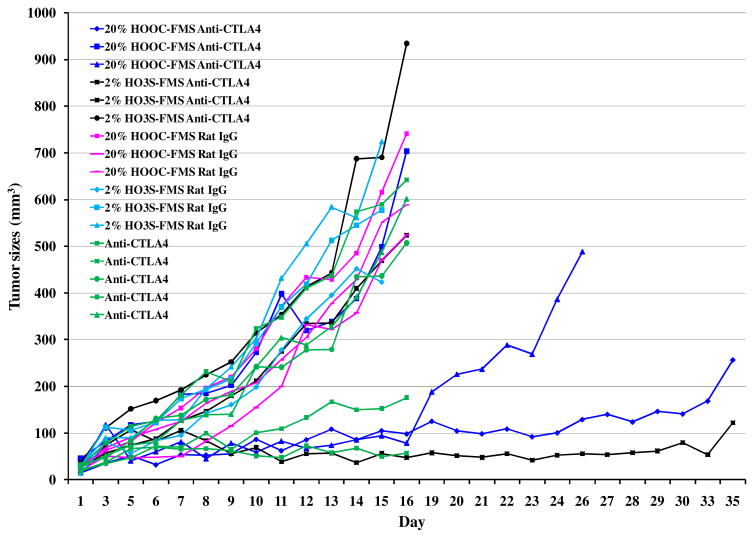Local Release of Highly Loaded Antibodies from Functionalized Nanoporous Support for Cancer Immunotherapy [Journal of the American Chemical Society 2010, 132, 6906–6907. DOI: 10.1021/ja102414t]. Chenghong Lei,* Pu Liu, Baowei Chen, Yumeng Mao, Heather Engelmann, Yongsoon Shin, Jade Jaffar, Ingegerd Hellstrom, Jun Liu,* and Karl Erik Hellstrom*
The original Figure 2A may give the erroneous impression that all mice receiving FMS-anti-CTLA4 mAb responded. The corrected Figure 2A here displays tumor growth and survival for each of all mice belonging to experimental and key control groups. The related text on Page 6907, left column, the 2cd to 9th line from the bottom should be changed: “…Figure 2A shows that intratumoral injection of FMS-anti-CTLA4 mAb inhibited tumor growth and prolonged survival in 3 of 6 mice comparing to intratumoral injection of FMS-rat IgG. We saw no evidence of toxicity from injecting FMS particles into tumors. Although systemic injection of “free” anti-CTLA4 mAb inhibited tumor growth in 2 of 5 mice, it did not prolong survival, most likely because of its toxicity. Figure 2B and 2C show similar results comparing intratumoral injection of FMS-anti-CTLA4 mAb with FMS-rat IgG in the repeat experiment with larger sampling and the difference was statistically significant. …”
Figure 2.
(A) Anti-tumor activity of (20% HOOC- and 2% HO3S-) FMS-anti-CTLA4 injected subcutaneously into small established, growing mouse melanomas (3 mice/group). Controls were free anti-CTLA4 in the absence of FMS (5 mice), (20% HOOC- and 2% HO3S-) FMS-Rat IgG (3 mice/group). 0.5 mg Anti-CTLA4 was used. 2 mice which got free anti-CTLA4 died on day 16.



